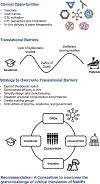Opportunities, Barriers, and a Strategy for Overcoming Translational Challenges to Therapeutic Nucleic Acid Nanotechnology
- PMID: 32706238
- PMCID: PMC7731581
- DOI: 10.1021/acsnano.0c04753
Opportunities, Barriers, and a Strategy for Overcoming Translational Challenges to Therapeutic Nucleic Acid Nanotechnology
Abstract
Recent clinical successes using therapeutic nucleic acids (TNAs) have accelerated the transition of nucleic acid nanotechnology toward therapeutic applications. Significant progress in the development, production, and characterization of nucleic acid nanomaterials and nucleic acid nanoparticles (NANPs), as well as abundant proof-of-concept data, are paving the way toward biomedical applications of these materials. This recent progress has catalyzed the development of new strategies for biosensing, imaging, drug delivery, and immunotherapies with previously unrecognized opportunities and identified some barriers that may impede the broader clinical translation of NANP technologies. A recent workshop sponsored by the Kavli Foundation and the Materials Research Society discussed the future directions and current challenges for the development of therapeutic nucleic acid nanotechnology. Herein, we communicate discussions on the opportunities, barriers, and strategies for realizing the clinical grand challenge of TNA nanotechnology, with a focus on ways to overcome barriers to advance NANPs to the clinic.
Figures

References
Publication types
MeSH terms
Substances
Grants and funding
LinkOut - more resources
Full Text Sources

